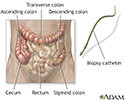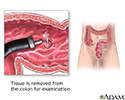Culture - colonic tissue
Colonic tissue culture
A colonic tissue culture is a lab test to check for the cause of disease. The sample of tissue for the test is taken from the large intestine during a sigmoidoscopy or colonoscopy.
How the Test is Performed
The health care provider removes a piece of tissue from your large intestine. This is done during a sigmoidoscopy or colonoscopy.
- The sample is sent to a lab.
- It is placed in a special dish that contains a gel. Bacteria and other organisms can grow in this gel. The dish is then stored at a certain temperature.
- The lab team checks the sample daily. They check to see if bacteria, viruses, or fungi have grown.
If certain germs grow, more tests will be done to identify them. This helps decide the best treatment.
How to Prepare for the Test
There is no specific preparation needed for a culture. In some cases, the provider performing the exam may recommend using an enema before the exam.
How the Test will Feel
Once the sample is taken, the culture does not involve you. Therefore, there is no pain.
Why the Test is Performed
Your provider may order this test if you have signs or symptoms of a large intestine infection. A culture is often done when other tests, such as a stool culture, could not identify the cause of infection.
Normal Results
A normal result means that no disease-causing organisms have grown in the lab dish.
Some "healthy" bacteria, called bowel flora, are normally found in the gut. The growth of such bacteria during this test does not mean there is an infection.
Normal value ranges may vary slightly among different laboratories. Talk to your provider about your test results.
What Abnormal Results Mean
An abnormal result means that disease-causing organisms have grown in the lab dish. These organisms may include:
- Clostridioides difficile bacteria
- Cytomegalovirus
- Mycobacterium tuberculosis bacteria
- Salmonella bacteria
- Shigella bacteria
These organisms may lead to colon infections or diarrhea.
Risks
There is very minimal risk associated with the procedure. In rare cases, excessive bleeding could occur when a tissue sample is taken.
References
DuPont HL, Okhuysen PC. Approach to the patient with suspected enteric infection. In: Goldman L, Schafer AI, eds. Goldman-Cecil Medicine. 26th ed. Philadelphia, PA: Elsevier; 2020:chap 267.
Melia JMP, Sears CL. Infectious enteritis and proctocolitis. In: Feldman M, Friedman LS, Brandt LJ, eds. Sleisenger and Fordtran's Gastrointestinal and Liver Disease. 11th ed. Philadelphia, PA: Elsevier; 2021:chap 110.
Siddiqi HA, Rabinowitz S, Axiotis CA. Laboratory diagnosis of gastrointestinal and pancreatic disorders. In: McPherson RA, Pincus MR, eds. Henry's Clinical Diagnosis and Management by Laboratory Methods. 24th ed. Philadelphia, PA: Elsevier; 2022:chap 23.
Wojewoda CM, Stempak LM. Medical bacteriology. In: McPherson RA, Pincus MR, eds. Henry's Clinical Diagnosis and Management by Laboratory Methods. 24th ed. Philadelphia, PA: Elsevier; 2022:chap 57.
Review Date: 5/6/2022
Reviewed By: Michael M. Phillips, MD, Emeritus Professor of Medicine, The George Washington University School of Medicine, Washington, DC. Also reviewed by David C. Dugdale, MD, Medical Director, Brenda Conaway, Editorial Director, and the A.D.A.M. Editorial team.







